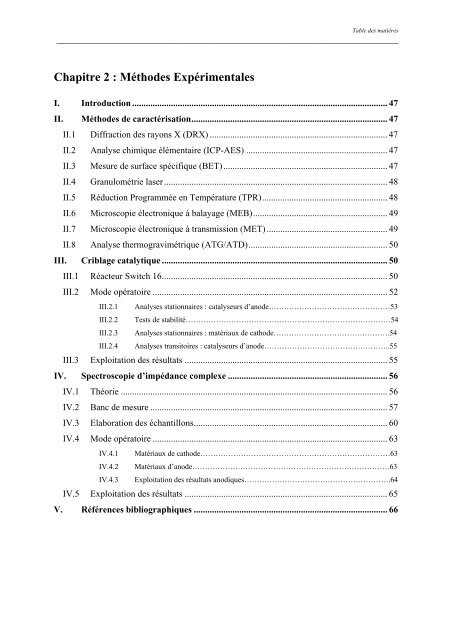Chapitre 3 - Université de Bourgogne
Chapitre 3 - Université de Bourgogne
Chapitre 3 - Université de Bourgogne
Create successful ePaper yourself
Turn your PDF publications into a flip-book with our unique Google optimized e-Paper software.
Table <strong>de</strong>s matières<br />
___________________________________________________________________________<br />
<strong>Chapitre</strong> 2 : Métho<strong>de</strong>s Expérimentales<br />
I. Introduction ................................................................................................................ 47<br />
II. Métho<strong>de</strong>s <strong>de</strong> caractérisation...................................................................................... 47<br />
II.1 Diffraction <strong>de</strong>s rayons X (DRX) .............................................................................. 47<br />
II.2 Analyse chimique élémentaire (ICP-AES) .............................................................. 47<br />
II.3 Mesure <strong>de</strong> surface spécifique (BET)........................................................................ 47<br />
II.4 Granulométrie laser.................................................................................................. 48<br />
II.5 Réduction Programmée en Température (TPR)....................................................... 48<br />
II.6 Microscopie électronique à balayage (MEB)........................................................... 49<br />
II.7 Microscopie électronique à transmission (MET)..................................................... 49<br />
II.8 Analyse thermogravimétrique (ATG/ATD)............................................................. 50<br />
III. Criblage catalytique ................................................................................................... 50<br />
III.1 Réacteur Switch 16................................................................................................... 50<br />
III.2 Mo<strong>de</strong> opératoire ....................................................................................................... 52<br />
III.2.1 Analyses stationnaires : catalyseurs d’ano<strong>de</strong>…………………………………………53<br />
III.2.2 Tests <strong>de</strong> stabilité………………………………………………………………………54<br />
III.2.3 Analyses stationnaires : matériaux <strong>de</strong> catho<strong>de</strong>……………………………………….54<br />
III.2.4 Analyses transitoires : catalyseurs d’ano<strong>de</strong>…………………………………………..55<br />
III.3 Exploitation <strong>de</strong>s résultats ......................................................................................... 55<br />
IV. Spectroscopie d’impédance complexe ...................................................................... 56<br />
IV.1 Théorie ..................................................................................................................... 56<br />
IV.2 Banc <strong>de</strong> mesure ........................................................................................................ 57<br />
IV.3 Elaboration <strong>de</strong>s échantillons..................................................................................... 60<br />
IV.4 Mo<strong>de</strong> opératoire ....................................................................................................... 63<br />
IV.4.1 Matériaux <strong>de</strong> catho<strong>de</strong>…………………………………………………………………63<br />
IV.4.2 Matériaux d’ano<strong>de</strong>……………………………………………………………………63<br />
IV.4.3 Exploitation <strong>de</strong>s résultats anodiques………………………………………………….64<br />
IV.5 Exploitation <strong>de</strong>s résultats ......................................................................................... 65<br />
V. Références bibliographiques ..................................................................................... 66
















